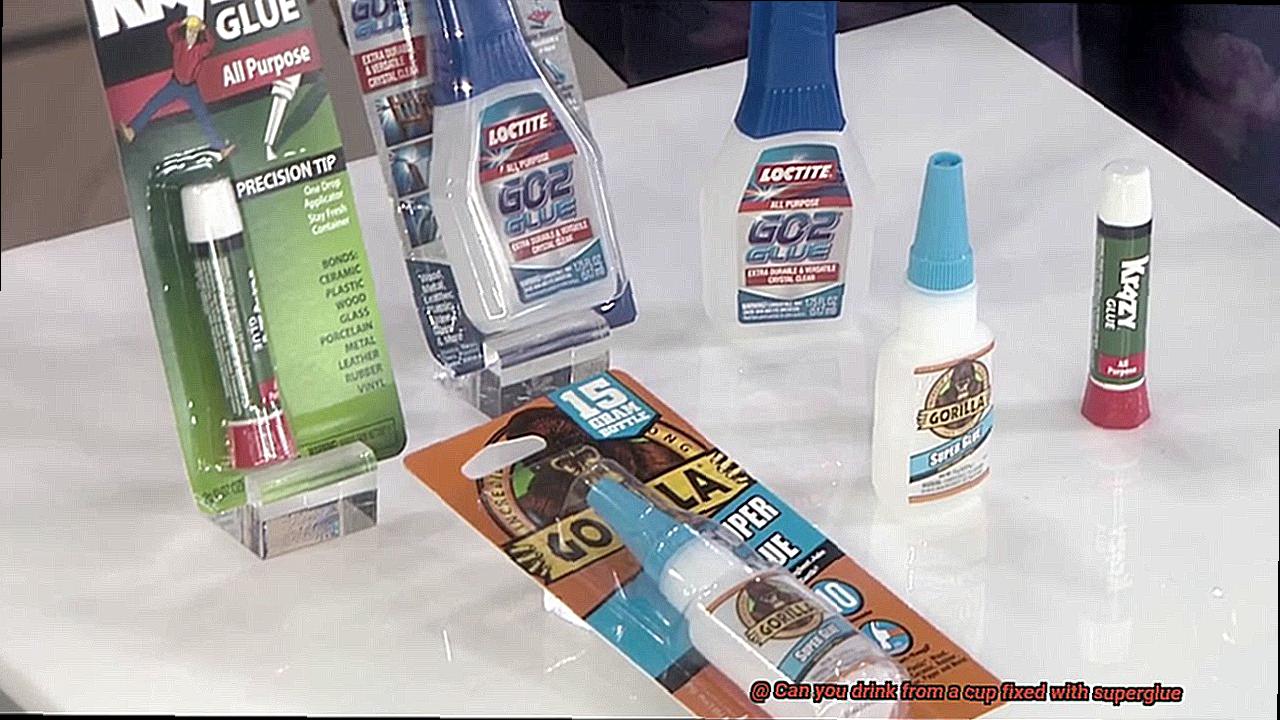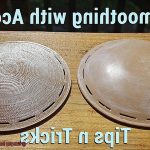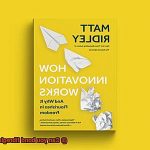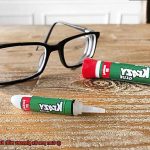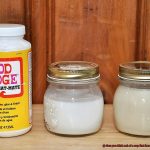Have you ever experienced that heart-wrenching moment when your beloved cup shatters into a thousand fragments? It’s like losing an old friend. But fret not, dear reader, for we may have stumbled upon a potential solution to this liquid tragedy. Imagine this: you’re dying of thirst, your go-to cup has suffered an unfortunate crack, but don’t despair just yet.
Today, we embark on a journey into the captivating realm of superglue and its magical ability to salvage our drinkware dilemmas. So take a seat, prepare yourself for some mind-bending chemistry, and let’s explore whether or not it’s possible to quench your thirst with a cup fixed by superglue.
What is Superglue?
Contents
Superglue, also known as cyanoacrylate adhesive, is a remarkable adhesive that offers rapid and robust bonding capabilities. It has become a staple in many households and industries for its versatility and strength. In this article, we will explore the uses, working mechanism, and limitations of this powerful adhesive.
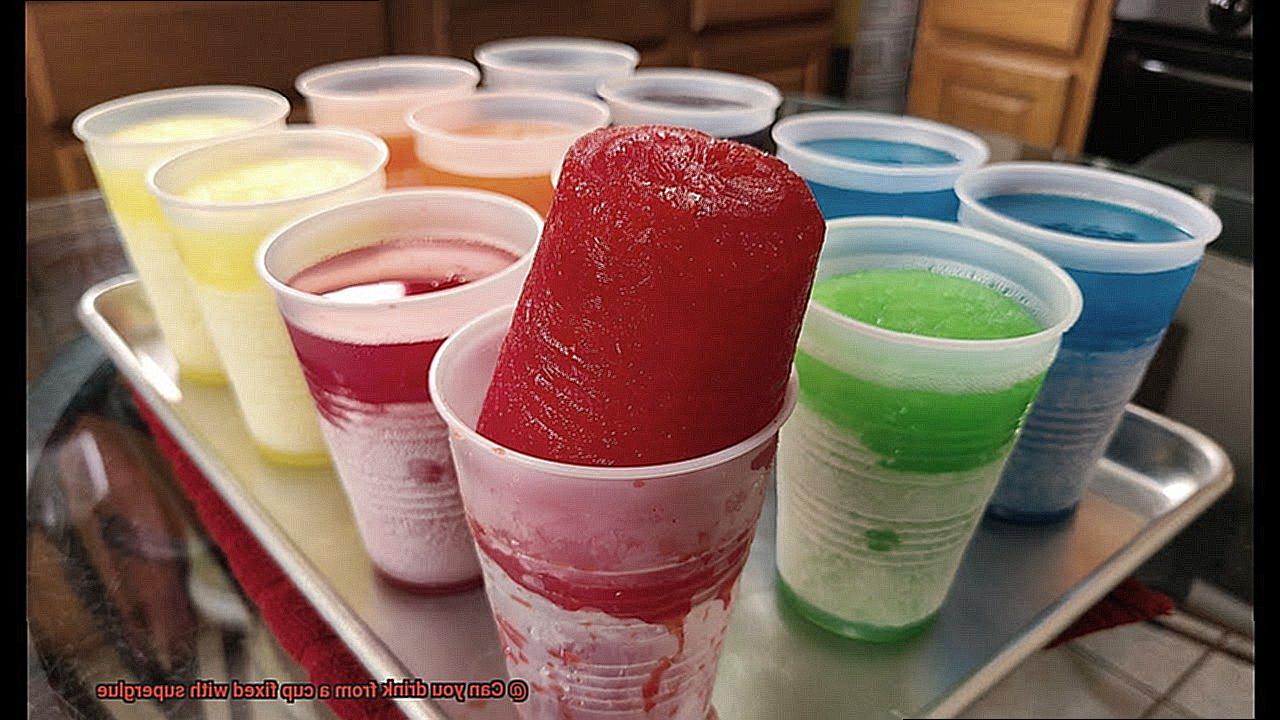
Versatility in Bonding:
Superglue exhibits excellent adhesion to a wide range of materials, making it incredibly versatile. From plastics and metals to ceramics and glass, this adhesive can bond them all. Even some fabrics and rubber can be effectively joined using superglue. Whether you need to repair a precious porcelain figurine or reattach a sole to a shoe, superglue provides a reliable and durable bond.
Rapid Cure Time:
One of the standout features of superglue is its lightning-fast curing time. Upon contact with moisture in the air or on the surfaces being bonded, the cyanoacrylate molecules undergo a polymerization reaction.
This reaction creates strong chains of molecules, resulting in a tight bond between the surfaces within seconds or minutes. This quick-drying nature makes superglue ideal for applications where immediate bonding is required.
Ideal for Small Repairs:
Superglue shines when it comes to repairing small objects or joining delicate parts together. Its strength and durability make it perfect for fixing eyeglass frames, jewelry, or ceramic ornaments.
The ability to bond smooth surfaces together with precision and speed makes superglue an invaluable tool for DIY enthusiasts and professionals alike. However, it may not be suitable for large-scale repairs or applications that require flexibility.
Limitations and Precautions:
While superglue is incredibly useful, it’s essential to understand its limitations and take necessary precautions:
- Limited Bonding on Oily or Low Surface Energy Surfaces: Superglue may not work effectively on surfaces that are oily or have low surface energy. Preparing the surface by cleaning it thoroughly or using primers can enhance adhesion.
- Potential Health Risks: Superglue can bond skin together instantly, leading to potential injuries. It is crucial to handle it with care, keep it away from children, and follow safety instructions provided by the manufacturer.
- Not Suitable for Food or Heat Exposure: Superglue is not food-safe and should not be used on items that come into contact with food or beverages. Additionally, it can become brittle when exposed to heat, making it unsuitable for high-temperature applications.
Health Risks of Drinking from a Cup Fixed with Superglue
While it may seem like a convenient solution, it’s important to be aware of the potential health risks associated with drinking from a cup fixed with this adhesive. In this blog post, we will delve into the world of superglue and explore why it might not be the best option for repairing your favorite mug.
The Dangers Lurking in the Air:
When superglue dries, it releases volatile organic compounds (VOCs) into the air. These VOCs can be ingested when drinking from a cup fixed with superglue, potentially causing health problems. Some common VOCs released include formaldehyde and acetone. Formaldehyde, a notorious carcinogen, poses a significant risk to your health. Meanwhile, acetone, known for its ability to irritate the respiratory system, can leave you with pounding headaches and debilitating dizziness.
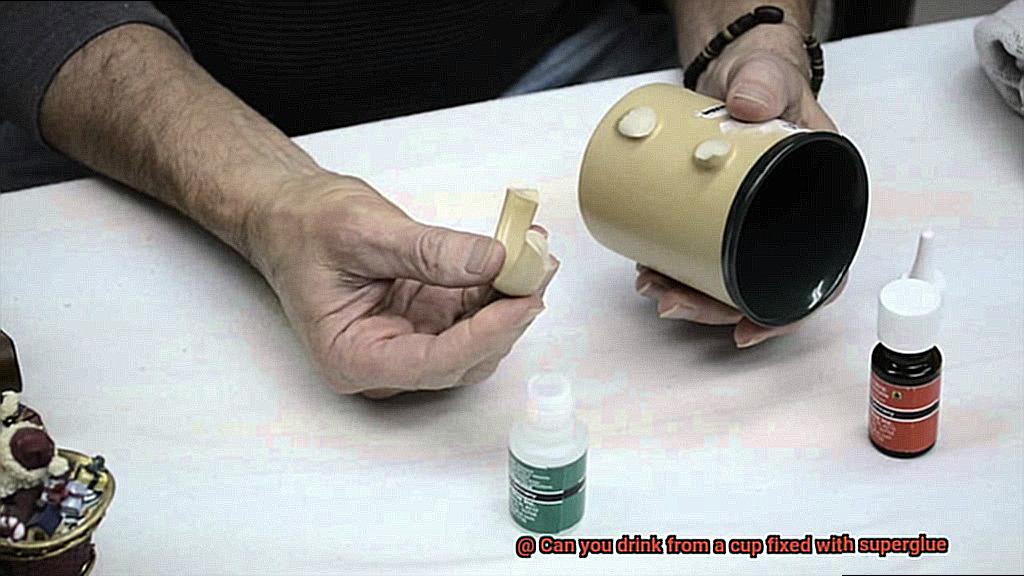
Chemical Leaching – A Silent Threat:
Another peril associated with drinking from a cup fixed with superglue is chemical leaching. Over time, exposure to liquids, especially hot ones, causes the glue to break down. As a result, harmful chemicals seep into your drink, wreaking havoc on your digestive system. Prepare yourself for unpleasant symptoms including stomach pain, nausea, and even vomiting.
Safer Alternatives:
To avoid these health hazards, it’s best to opt for safer alternatives when repairing cups or mugs. Look for food-safe adhesives specifically designed for kitchenware repairs. These adhesives are formulated to be non-toxic and safe for contact with food and beverages. By using these safer options, you can fix your cup without worrying about ingesting harmful chemicals.
Chemical Migration Risk
When it comes to the safety of our food and beverages, we often overlook the potential risks associated with the materials used in their containers. Chemical migration is a significant concern, as it refers to the transfer of chemicals from one material to another, such as from an adhesive used to fix a cup to the liquid inside. This article delves into the hidden dangers of chemical migration and provides insights into how to mitigate these risks.
Chemical Migration and Superglue:
Superglue, or cyanoacrylate adhesive, is a popular choice for bonding various materials together due to its fast-acting and strong capabilities. However, using superglue in food and beverage containers can present risks. The ingredients in superglue, including cyanoacrylate monomers, stabilizers, and additives, may seep into the liquid or food being consumed.
Safety Concerns:
Superglue is not intended for direct contact with food or beverages. Manufacturers explicitly advise against using it on items that come into contact with consumables. Instead, opt for adhesives specifically designed for food-safe applications to ensure consumer safety.
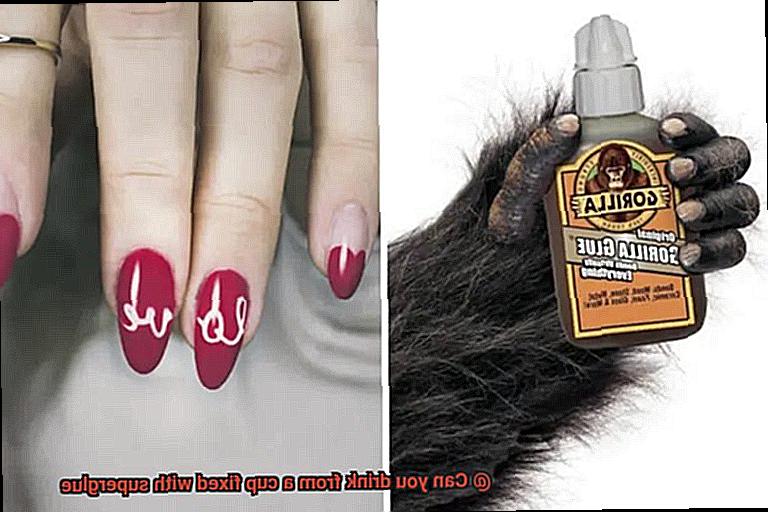
Harmful Fumes:
Certain types of superglue can release harmful fumes or odors when exposed to moisture or heat. These fumes can contaminate the contents of a cup fixed with superglue, making it unsafe for consumption. It is essential to consider the potential health risks associated with inhaling these fumes.
Physical Contamination:
Over time, the adhesive bond in a cup repaired with superglue may weaken, resulting in small particles or flakes mixing with the liquid or food. This poses a potential choking hazard or other adverse effects if ingested.
Increased Safety Hazards
Imagine starting your day with a sip of coffee from a cup you’ve lovingly repaired with superglue. Seems harmless, right? Well, think again. Believe it or not, drinking from a cup fixed with superglue can actually put your safety at risk. In this eye-opening article, we’ll delve into the potential dangers and risks associated with using superglue for cup repairs. So, fasten your seatbelt and get ready to be enlightened.
Toxicity of Superglue:
Superglue contains chemicals like cyanoacrylate that are far from harmless. Ingesting large quantities of this glue can have toxic effects on the body. Just imagine accidentally swallowing it. Not only can it cause painful irritation and burns in your mouth and throat, but it can also wreak havoc on your respiratory and gastrointestinal systems. Talk about a nightmare.
Leaching of Chemicals:
Superglue isn’t designed to be food-safe or waterproof, which means the chemicals in the glue can seep into your drink over time. That innocent morning coffee might end up tainted with harmful substances. Who wants to start their day with a sip of chemical-laden brew? Certainly not you.
Structural Integrity Compromised:
Sure, superglue can bond materials together, but it might not provide a strong enough bond to maintain the structural integrity of a cup. When exposed to heat or moisture from hot beverages, the adhesive properties of the glue can weaken, putting your cup at risk of breaking or collapsing when you least expect it. Can you imagine the pain of shards cutting your lip? Ouch.
Choking Hazards:
Sipping from a cup fixed with superglue can quickly turn into a choking hazard. If the bond between the cup’s pieces weakens or fails while you’re mid-sip, fragments of superglue or broken cup shards could end up in your mouth. Not the extra crunch you were expecting, right? This is a recipe for disaster.
Cleaning Nightmare:
Cleaning cups fixed with superglue can be an absolute nightmare. The glue creates rough surfaces and hidden crevices that are nearly impossible to reach with regular cleaning tools. This makes it a breeding ground for bacteria and other contaminants, exposing you to the risk of foodborne illnesses or infections. No one wants a side of bacteria with their morning tea.
Affects on the Cup’s Appearance and Usability
Today, we’re delving into the world of cup repairs and the potential pitfalls of using superglue. While it may seem like an easy fix, beware. We’ll explore how this quick solution can lead to unappealing appearances and compromised usability. So grab a cuppa and let’s dive in.
Appearance Woes:
When you reach for your repaired cup, you may notice unsightly marks left behind by the superglue. These marks can range from small dots to larger streaks, depending on how well the glue adhered. Additionally, the application of superglue can create a rough texture on your cup, making it less visually appealing.
Usability Woes:
Superglue repairs may lack the strength of the original cup, leaving glued areas more susceptible to cracking or even breaking. Imagine the disappointment of pouring hot coffee only to have your beloved cup shatter. Furthermore, heat weakens the bond created by superglue, compromising its durability. This makes it particularly risky when using the cup for hot liquids. Additionally, superglue is not typically food-safe, raising concerns about potential health risks if it comes into contact with your beverages or food.
Moisture and Time:
Superglue’s resistance to moisture and heat is limited. Over time, exposure to these elements can cause glued areas to degrade and break apart, rendering your cup even more unusable. Even if your repaired cup appears to hold up initially, there’s no guarantee it won’t fail unexpectedly in the future, leading to spills or accidents.
Alternative Solutions for Repairing Broken Cups
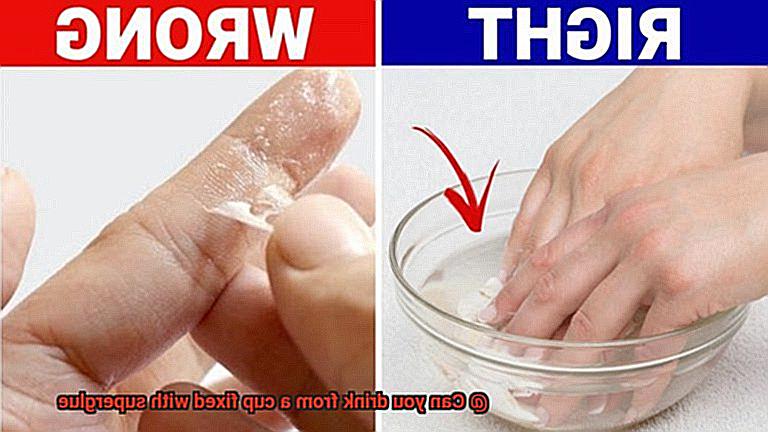
I’ve got some exciting alternative solutions up my sleeve that will leave your cup looking brand new and ready to hold your favorite beverage. Get ready for a thrilling journey into the world of cup repair.
Let’s start with a game-changer – food-safe epoxy. This specially formulated adhesive is designed for kitchenware repair, ensuring a non-toxic and food-safe bond. Look out for epoxies that proudly declare their food-grade status, so you can repair your cup without any worries.
If you’re dealing with a delicate ceramic cup, consider diving into the world of ceramic repair kits. These kits are like the superheroes of cup repair, equipped with everything you need to seamlessly fix your broken cup. From adhesive to filler and even colorant, these kits provide a complete solution that will make your cup look as good as new. Your cup will be ready to hold your morning coffee in no time.
But wait, there’s more. Have you ever heard of silicone adhesive? This flexible and durable adhesive forms an unbreakable bond between ceramic surfaces. Its resistance to water and heat makes it perfect for fixing cups that endure daily use. Just make sure you choose a food-grade silicone adhesive that’s suitable for drinking vessels – safety first.
Now, brace yourself for something truly unique – Sugru. This magical moldable glue is a cup repair wizard. It bonds exceptionally well with ceramics and becomes food-safe once it cures. But here’s the best part – it comes in various colors. You can match the repaired cup to your liking and turn it into a work of art while ensuring its longevity.
But what about metal cups? Don’t worry, we’ve got an alternative for those too. Enter welding – the heavy-duty solution for metal cups. Now, before you attempt this option, remember that welding should only be done by trained professionals. Safety is paramount when it comes to cup repair, so leave this one to the experts.
Prioritizing Your Health and Safety
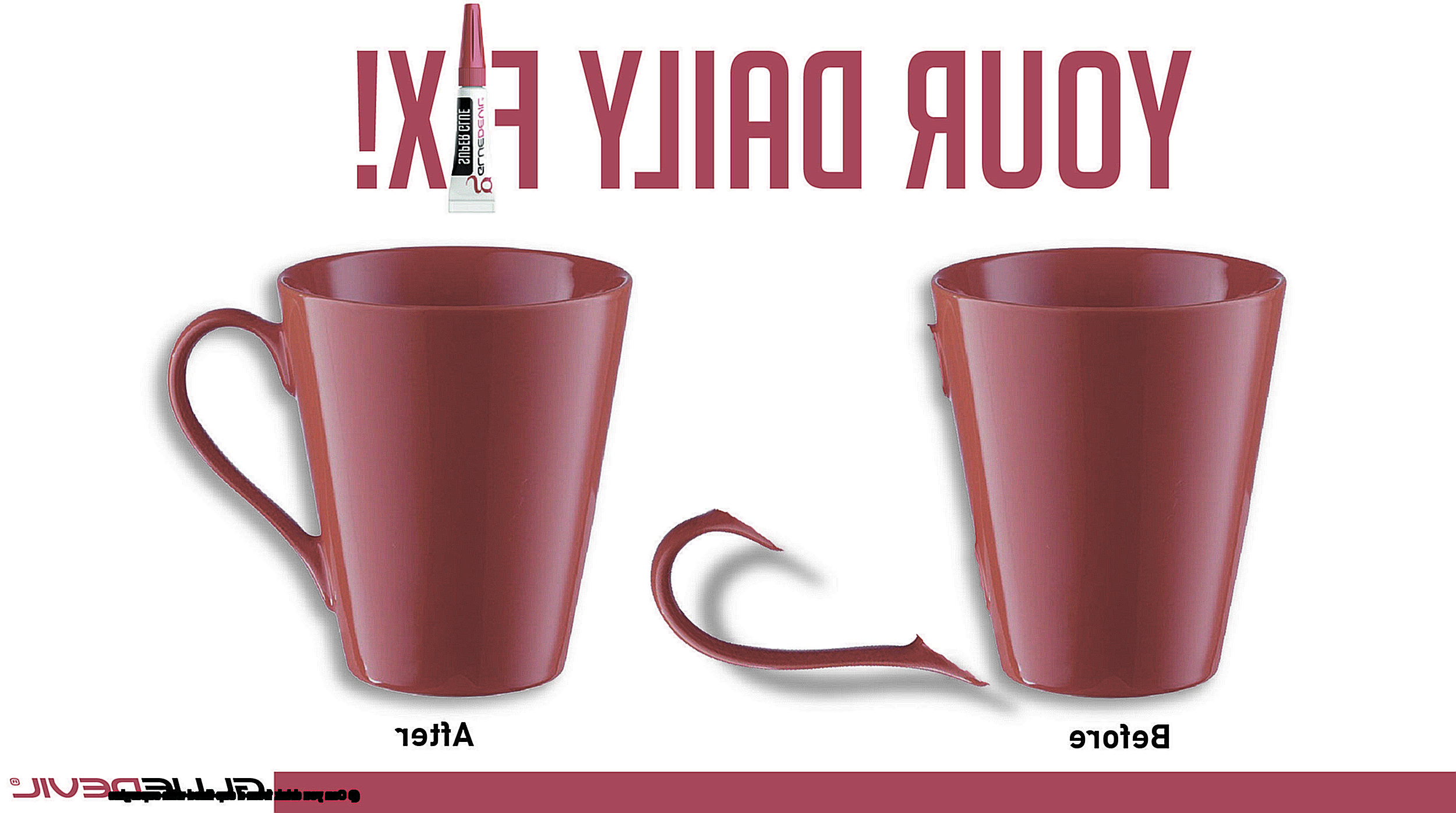
Step into the world of cup repair and discover why prioritizing your health and safety is crucial. While the quick fix of superglue may be tempting, it’s time to explore the potential risks and alternative options that will keep you sipping worry-free.
The Risks Involved:
- Chemical Contamination: Superglue’s chemical composition can seep into your drink, contaminating it with potentially harmful substances. Don’t let your favorite beverage become a toxic cocktail.
- Toxicity: Ingesting large quantities of cyanoacrylate, a primary ingredient in superglue, can be toxic. Even small amounts can irritate your delicate gastrointestinal tract, causing discomfort.
- Unknown Reactions: The aftermath of mixing superglue with liquids is largely uncharted territory. The unpredictable nature of this combination leaves you vulnerable to unforeseen adverse reactions.
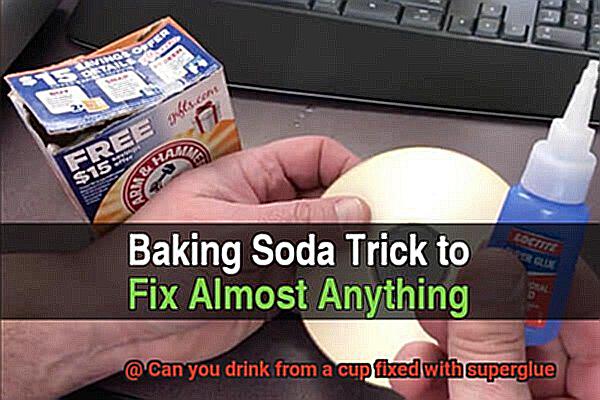
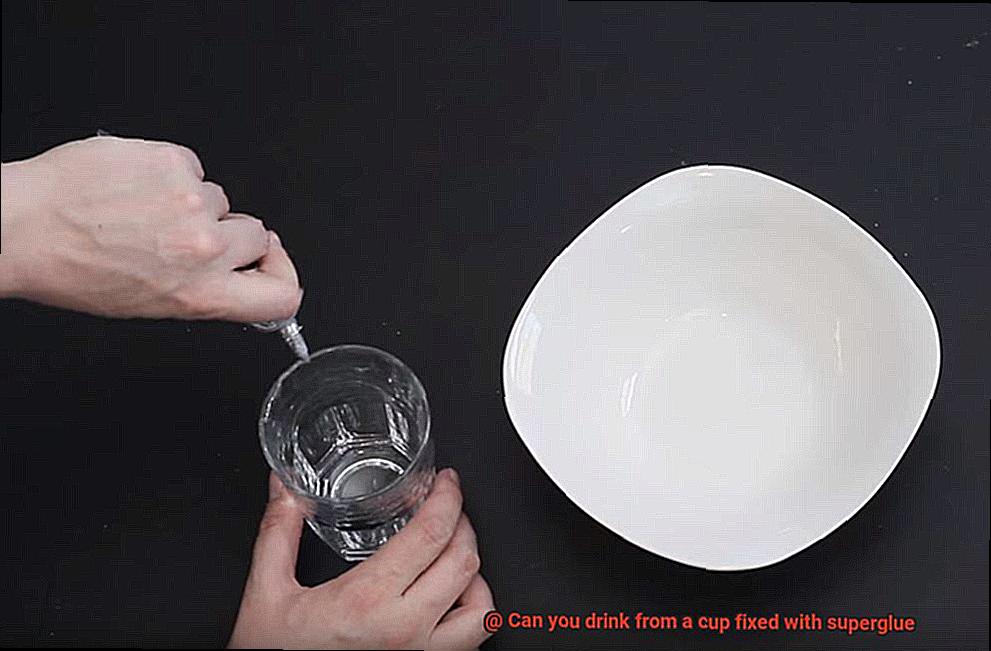
Alternatives to Consider:
- Food-Safe Epoxy: Seek out epoxy specifically formulated for food-related repairs. These adhesives are dishwasher-safe and maintain their integrity when in contact with food or drinks.
- Ceramic Repair Kits: If you’re dealing with a broken ceramic cup, opt for a specialized ceramic repair kit. These kits offer superior bonding strength over superglue while ensuring your beverage remains safe to consume.
- Silicone Adhesive: Harness the flexibility and durability of silicone-based adhesives that are commonly used in food-grade applications. These adhesives provide a secure bond without compromising your health.
eP3xJIJ-TbU” >
Also Read: What glue can I use to reattach a crown?
Conclusion
In conclusion, it may be tempting to take a swig from a cup that’s been fixed with superglue for its quick-fix convenience. However, I strongly advise against it for several compelling reasons.
First and foremost, superglue is not meant for food consumption. When exposed to heat or moisture, this adhesive can release toxic fumes and chemicals that have no place mingling with your drink. Think irritation, burns, respiratory issues, and even stomach troubles. Not exactly the refreshing experience you were hoping for.
But wait, there’s more. The bond created by superglue might not hold up under the pressure of everyday use or hot liquids. Over time, this adhesive’s strength weakens when faced with heat or moisture. So imagine sipping on your piping hot coffee only to have your cup crumble in your hands or worse yet, find yourself picking shards out of your mouth. Yikes.
And let’s not forget about cleanliness. Cups fixed with superglue can be a breeding ground for bacteria thanks to their rough surfaces and hidden crevices. It’s like an invitation for foodborne illnesses and infections to crash your party.
Instead of taking unnecessary risks with your health and safety, consider exploring alternative solutions for fixing broken cups. There are plenty of options out there that prioritize both durability and your well-being. Look into food-safe epoxy, ceramic repair kits, or silicone adhesives specifically designed for food-grade applications. These alternatives will give you peace of mind while you sip away without any worries about potential hazards lurking in your cup.
Remember: when it comes to your favorite cup and your health, caution should always be the name of the game.

